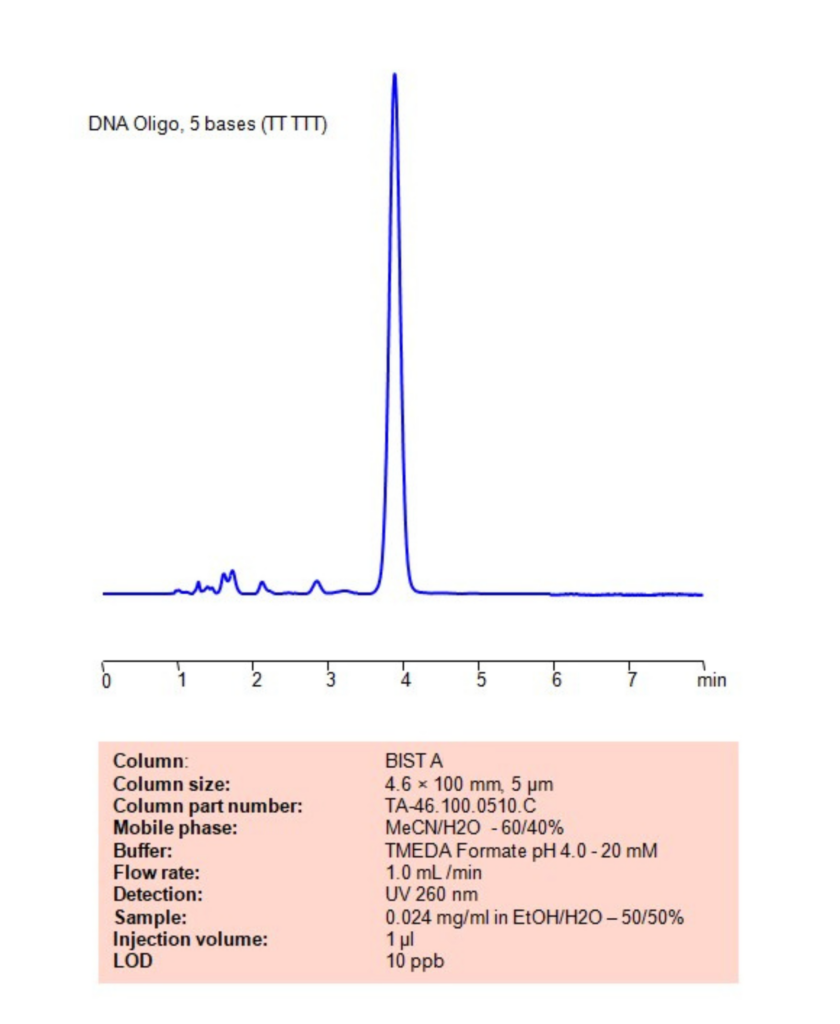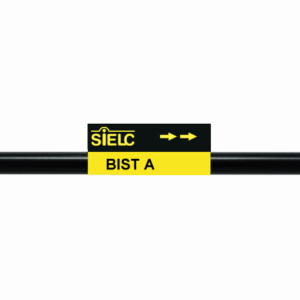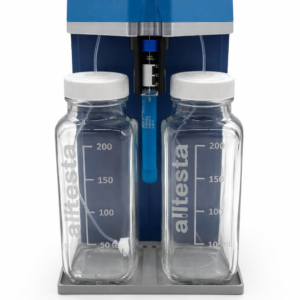Separation type: Bridge Ion Separation Technology, or BIST™ by SIELC Technologies
HPLC Method for Analysis of DNA Oligo, 5 bases (TT TTT) on BIST A Column by SIELC Technologies

High Performance Liquid Chromatography (HPLC) Method for Analysis of DNA Oligo, 5 bases (TT TTT)
DNA oligos, short for oligonucleotides, are small fragments of DNA that are often synthesized for various scientific and medical applications. A DNA oligo with a sequence of 5 thymine bases, denoted as “TTTTT,” has some specific properties and uses:
Properties:
Composition: This oligo is composed of five thymine (T) nucleotides, which are pyrimidine bases.
Stability: Thymine-rich oligos can have different stability characteristics compared to those rich in other nucleotides. The stability of DNA strands is influenced by base stacking interactions and hydrogen bonding.
Hybridization Potential: The ability of this oligo to hybridize (bind) with other DNA or RNA sequences is limited due to its homopolymer nature. It would preferentially bind to sequences rich in adenine (A).
Uses:
- Molecular Probes: It can be used as a probe in molecular biology experiments to bind to complementary sequences.
- Polymerase Chain Reaction (PCR): These oligos can serve as primers in PCR, but their effectiveness is limited due to the repetitive nature of the sequence.
- Research: In research, such oligos can be used to study the properties of DNA, DNA-protein interactions, and the mechanisms of enzymes that interact with DNA.
- Control Experiments: Due to its simplicity, it can be used in control experiments to compare with more complex oligonucleotides.
Limitations:
- Non-specific Binding: The homopolymer sequence may lead to non-specific binding in certain applications.
- Lower Melting Temperature: Homopolymers like “TTTTT” tend to have lower melting temperatures, which could affect their use in temperature-sensitive applications.
DNA oligo with the sequence “TTTTT” has unique properties related to its homopolymer nature and finds specific uses in molecular biology, although it also has some limitations due to its repetitive sequence.
Using SIELC’s newly introduced BIST™ method, this oligonucleotide can be retained on a negatively-charged, cation-exchange BIST™ A column. There are two keys to this retention method: 1) a multi-charged, positive buffer, such as TMEDA formate, which acts as a bridge, linking the negatively charged dye to the negatively-charged column surface and 2) a mobile phase consisting mostly of organic solvent (such as MeCN) to minimize the formation of a solvation layer around the charged analytes. Using this new and unique analysis method, oligonucleotide can be separated, retained, and detected at 260 nm.
Please read more on oligonucleotides analysis by HPLC in our April’s 2023 newsletter.
Condition
| Column | BIST A, 4.6 x 100 mm, 5 µm, 100 A, surface coated |
| Mobile Phase | MeCN – 60% |
| Buffer | TMEDA Formate pH 4.0 – 20 mM |
| Flow Rate | 1.0 ml/min |
| Detection | UV 260 nm |
| Sample | 0.024 mg/ml in EtOH/H2O – 50/50% |
| Injection volume | 1 µl |
| LOD* | 10 ppb |
Description
| Class of Compounds | Oligonucleotides |
| Analyzing Compounds | Oligonucleotides |
Application Column
BIST A
Column Diameter: 4.6 mm
Column Length: 100 mm
Particle Size: 5 µm
Pore Size: 100 A
Column options: surface coated





